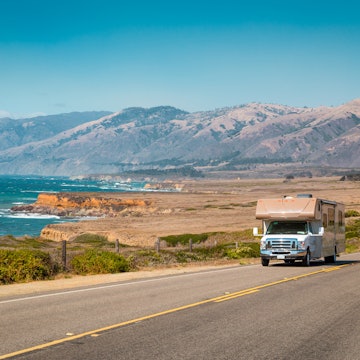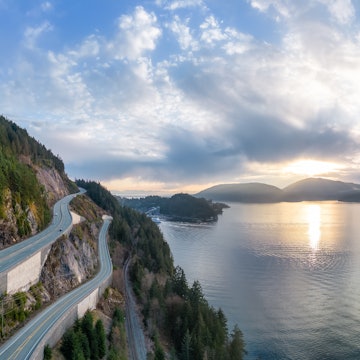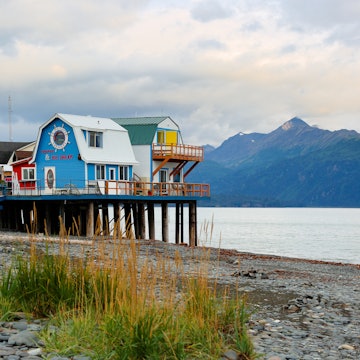

From choosing routes to buying tickets, we can answer all your questions about traveling on the Alaska Marine Highway System © FloridaStock / Shutterstock
Traveling aboard a ferry on the Alaska Marine Highway System (AMHS) network that connects Alaska's coastal communities provides the same views and similar routes as cruise ships but without the fluff. It also allows visitors to experience smaller communities that cruise ships typically skip.
Passengers along the Inside Passage see glimpses of glaciers, wildlife and lush forests. They can also meet the residents who travel the ferries regularly. Traveling the Alaska Marine Highway System allows travelers to experience life in rural Alaska and see its stunning environs without the price tag of cruise ships.
Ferry travel requires advance planning and execution, as the Alaska Marine Highway is a designated All-American Road. It is the first waterway to be named such, and its 3,500-mile scenic byway is popular with independent travelers and their cars, RVs, bicycles and motorcycles. Limited service to some areas makes tickets a hot commodity in-season.

What is the Alaska Marine Highway System (AMHS)?
Known fondly as the "blue canoes" by residents, the state-owned and operated ferries of the AMHS are integral to basic living and commerce for coastal communities of the state. First launched in 1948 as a small marine transport founded by two brothers who saw a need to help get residents and products between the small towns of Haines, Skagway and Tee Harbor in Southeast Alaska, the ferry system of today didn’t become a state entity until 1963. Then, the newly launched MV Malaspina arrived in Ketchikan to much fanfare because, as one resident said, “We could finally go somewhere!”
Of Alaska's five regions, three are along the coastline: Southeast, Southcentral and Southwest. The Alaska Marine Highway’s fleet of vessels is critical to transporting people and goods over a 30-route system. It also provides visitors with an experience that truly emulates the Alaska lifestyle.

Want to combine your ferry adventure with air, train, or road experiences? Here’s how to get around Alaska in addition to the ferry
What are the main routes on the AMHS?
Alaska State Ferry routes vary in distance and length, from a few hours to more than a day, depending upon the communities served. The entire length of the system stretches from Bellingham, Washington, to Dutch Harbor in Alaska’s Aleutian Islands, servicing more than 30 communities along the way. The longest running time point-to-point is 38 hours from Bellingham to Ketchikan.
Looking for a snapshot of Alaska’s coastal regions with plenty of activities and stunning scenery? The following itineraries are a great trip to tack on to land-based travel, or as a full vacation in themselves.
Important note: As of August 23, 2024, the Alaska Department of Transportation has advised that all cross-gulf and Prince Rupert sailings are canceled for the 2024-2025 winter schedule due to required emissions upgrades to the certified ocean class vessel that serves these routes.
Route 1: Whittier to Valdez (Southcentral)
The fishing industry is one of Alaska’s top economic engines, so traveling Prince William Sound during summer in Alaska means a front-row seat to the vessels and people working nets and lines. This five-hour trip sails among the placid bays and craggy coves of the sound, with the stunning Chugach National Forest as a backdrop. Popular because of its sail-drive connection via the Richardson and Glenn Highways between Anchorage, Whittier and Fairbanks, this a wonderful route for those looking for a round-trip journey. Watch for fishing boats, kayakers camping on the shoreline and "bergy bits" from the massive Columbia Glacier as you get closer to Valdez, then stay overnight in town before hitting the road north or west.
Once you arrive in Valdez, make sure to stop at the Valdez Museum for a dive into area history, including events like a 9.2 earthquake in 1964 and the Exxon Valdez oil spill in 1989. Old Town Valdez is the former downtown district prior to the 1964 quake, when a tsunami destroyed nearly every building and the entire community relocated to its current site.
A few miles out of town, Solomon Gulch Hatchery is a great place to watch sea lions and the occasional brown or black bear fishing for pink salmon returning to the hatchery. A glacier and wildlife cruise departing from the Valdez harbor can provide up-close views of these rivers of ice and whales cavorting in Prince William Sound.
Other routes to consider: If you’re based in Anchorage, you can travel the Alaska Marine Highway ferry system between Whittier, Cordova and Valdez, then drive back to Anchorage for a loop. This trip showcases Prince William Sound and provides more opportunities for wildlife viewing and hiking local trails in Cordova.
Route 2: Juneau to Haines (Southeast)
Departing from Auke Bay, a short distance from downtown Juneau, the sail to Haines is just under four hours and is frequently traveled by residents going back and forth for shopping, appointments or sports contests. Look for whales, seals and eagles as you move along the Inside Passage before turning into scenic Lynn Canal.
Haines itself is a quaint little town that happens to be located a mere 45 miles from the Canadian border, and is one of few Southeast Alaska communities that is accessible by road, water and air. Unlike neighboring Skagway (just 20 more miles up Chilkoot Inlet from Haines), Haines has resisted the tourist trappings of a cruise ship port city, and visitors wanting to hike, paddle or experience museums and cultural centers without heavy crowds will enjoy this destination.
Haines is also a great jumping-off city for road-tripping into Canada's Yukon Territory and then back into Alaska via the famous Alaska Highway (or ALCAN Highway). Note that a passport is required for multiple border crossings.
Other routes to consider: If you're basing yourself in Juneau, consider adding a weekend in Angoon (5 hours), Hoonah (3.5-7 hours) or Skagway (6 hours). Both Angoon and Hoonah are located in the pristine Tongass National Forest and offer many opportunities for fishing, kayaking and wildlife viewing. They are also both home to the Native Tlingit people, with the largest community being in Hoonah. Skagway, meanwhile, preserves history with the Klondike Gold Rush National Historical Park.

Route 3: Homer to Dutch Harbor (Southwest)
This is the route for serious adventurers who want to explore remote coastal Alaska. The Southwest route begins in the small town of Homer at the end of Southcentral Alaska's Kenai Peninsula. Located just over 200 miles south of Anchorage (about a five-hour drive), Homer is known for its thriving halibut fishing and access to a plethora of hiking and camping across scenic Kachemak Bay.
Typically, the ferry departs in the evening for an overnight Gulf of Alaska crossing, arriving in Kodiak city on Kodiak Island early the following morning. From Kodiak, the ferry proceeds across Shelikof Strait toward the Alaska Peninsula before reaching the Aleutian Islands. Often, travelers can see steam rising from one of the many active volcanoes in the region and the occasional whale spouting off in the distance.
Planning your trip to Alaska? Here's our seasonal guide to help you choose the best time for your visit
How do I book a ferry trip?
Booking online is the easiest way to score your tickets on the Alaska State ferry. The website is run by the State of Alaska and has its kinks, but reservation agents are very helpful on the phone (1-800-642-0066). Keep in mind that onboard amenities are basic, not at all comparable to a cruise. All ferries operating on an Alaska State Ferry route have elevators, and all vessels with staterooms have at least one stateroom that is wheelchair accessible.
If you choose a multi-day sailing, a stateroom is much desired over sleeping in the main common areas or on deck. Cabins are single or double occupancy with bunk-bed style berths, and most have a private bathroom. Reserve these as far in advance as possible, as they sell out quickly.
If the idea of sleeping al fresco on deck sounds like an Alaska-themed must-do adventure, pay attention to posted placards letting passengers know where they may and may not sleep outside. Small tents are permitted to be pitched on some upper decks, but it is imperative they be secured with duct tape to keep them from blowing away during the trip. Deck lounge chairs under heat lamps in the solarium spaces may be accessible to overnighters as well, but not every ferry has them. Use lockers inside common areas for stashing valuables, as gear will be open to both the elements and other people otherwise.

When do tickets become available?
The Alaska Marine Highway System releases its summer schedules in early spring each year, and tickets for popular Southeast and Southwest routes are at a premium. A good strategy is to follow the AMHS on social media channels and check the website frequently. Be as flexible as possible with travel dates, since long weekends and holidays are extremely busy.
Need more inspiration? Here are the best things to do in Alaska
What do I pack? What can I bring on board?
Personal food and non-alcoholic beverages are permitted in the cafeteria area. Bring a cooler for perishable items. Food is also available for purchase. Alcohol is permitted only in staterooms.
Bring warm clothing and rain gear to spend ample time outdoors on deck. Non-slip waterproof shoes are a must for wet conditions.
If you plan to camp, bring all the gear you need, including a tent and sleeping bag. Gear is not available for rent or purchase on board.
Pack binoculars to spot whales and other wildlife. Ferry crew usually announce when animals or birds are seen.
Do not forget government-issued ID, charging cords, and cash or credit cards to purchase food and other items on board.
Dogs and cats are permitted, but only on the car deck and in an approved travel carrier or in a vehicle. U.S. Coast Guard regulations restrict access to the car deck while sailing is underway, so pet owners cannot spend the entire trip with their pets. On extended sailings, pet relief calls are announced at the discretion of the Captain approximately every eight hours.
Service animals are permitted to accompany a person with a disability at all times. Comfort/therapy animals are subject to the same restrictions as other pets.
What's it like on board?
The Alaska Marine Highway System ferries are very busy in the summer months, with passengers staking claims in all common spaces for the duration of a trip. If you do not reserve a stateroom, bring coins for lockers to secure valuables and jump into the spirit of independent travel.
Make time to dine in the vessel’s cafeteria and meet other travelers, for this is an excellent opportunity to become acquainted with life on Alaska's coast.
Consider bringing your own water bottle, mug for coffee or tea, and snacks/camp-style meals if you are on a multi-day itinerary.
The Alaska Marine Highway System has a complete list of things to know and travel policies on its website.
Keep planning your trip to Alaska
Add on to your ferry experience:
The bus system in Anchorage is fairly robust and connects to transportation elsewhere in the state. Check out the Alaska Native Heritage Center if time won’t allow you to experience local culture firsthand.
Mixing cities and towns with the wilds is part of the classic Alaska experience. Park Connection buses provide transport to Denali National Park and Talkeetna from Anchorage and Seward.
If you want to explore a bit by plane, consider a milk run with Alaska Airlines, which always departs from Anchorage or Seattle. Many villages are only accessible by air, especially in the winter.
Consider a trip on the Alaskan Railroad, which is considered one of the most scenic rides in the world. The train will slow or stop for wildlife viewing while en route. Take the train from Anchorage or Seward to Denali or Fairbanks, the only interior “city” in all of Alaska and the most easily accessible place with a chance to view the Northern Lights.
If you’ve decided the ferry isn’t for you, check out cruises to Alaska.
Alaska is a land with great variation across seasons, and the best time to visit will depend on what you hope to get out of your trip.
If you want to maximize your Alaska experience but keep the spending reasonable, travel in Alaska on a budget with these tips.
















